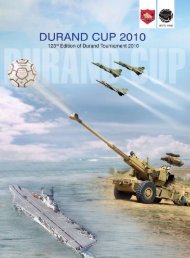Shimla-the birthplace of the Durand Cup and the Indian Air Force ...
Shimla-the birthplace of the Durand Cup and the Indian Air Force ...
Shimla-the birthplace of the Durand Cup and the Indian Air Force ...
Create successful ePaper yourself
Turn your PDF publications into a flip-book with our unique Google optimized e-Paper software.
as one <strong>of</strong> <strong>the</strong> finalists for regimental army teams. Regimental<br />
teams nowadays play before a few hundred spectators as <strong>the</strong>y<br />
no longer have <strong>the</strong> charisma or talented players, for spectators<br />
to flock to <strong>the</strong> Ambedkar stadium to see <strong>the</strong>m in action. This<br />
decline is both sad <strong>and</strong> baffling but is an apt reflection <strong>of</strong><br />
changing values in society <strong>and</strong> receding interest in regimental<br />
sports. It seems like an age gone by, but in <strong>the</strong> 1966 <strong>Dur<strong>and</strong></strong><br />
tournament, three <strong>of</strong> <strong>the</strong> semi-finalists were regimental teams<br />
from <strong>the</strong> Services, <strong>the</strong> ultimate winners Gorkha Briagde,<br />
runners-up Sikh Regimental Centre (SRC) from Meerut <strong>and</strong><br />
EME Secunderabad. Mohun Bagan was <strong>the</strong> only civilian side<br />
in <strong>the</strong> last four <strong>of</strong> <strong>the</strong> tournament. The 950s <strong>and</strong> 1960s were<br />
<strong>the</strong> heydays <strong>of</strong> regimental teams in <strong>the</strong> <strong>Dur<strong>and</strong></strong> tournament. In<br />
1965, <strong>the</strong> newly formed Delhi Garrison, formed after <strong>the</strong> 1965<br />
Indo-Pak conflict was <strong>the</strong> cynosure <strong>of</strong> all attention. This crack<br />
regimental team, with stalwarts like Bhupender Singh Rawat,<br />
K.B. Sharma <strong>and</strong> Amar bahadur upfront <strong>and</strong> Khairuddin <strong>and</strong><br />
Mahadevan in defence <strong>and</strong> Arvinder Singh as goalkeeper<br />
delighted <strong>the</strong> crowds with <strong>the</strong>ir attacking, spirited football.<br />
They upset mighty East Bengal, which included stalwarts like<br />
Peter Thangaraj, Sukumar Samajpati, Parimal Dey, Sushil<br />
Sinha <strong>and</strong> P. Sinha in <strong>the</strong>ir ranks, 1 -0 in <strong>the</strong> quarterfinals. In<br />
<strong>the</strong> semi-finals Punjab Police upset <strong>the</strong>m.<br />
MRC Wellington was a name to conjure with in <strong>the</strong> <strong>Dur<strong>and</strong></strong><br />
tournament. In <strong>the</strong> 1950s <strong>and</strong> early 1960s <strong>the</strong>y were a wellknit<br />
team <strong>of</strong> <strong>the</strong> most successful <strong>and</strong> best goalkeepers India<br />
has produced. He was involved in both <strong>the</strong>ir <strong>Dur<strong>and</strong></strong> triumphs<br />
<strong>of</strong> 1955 <strong>and</strong> 1958 <strong>and</strong> left for Mohammedan Sporting, Calcutta<br />
only in 1961, after having played in two Olympics, Asian Games<br />
<strong>and</strong> Asia <strong>Cup</strong>. Inside forward Kuppaswamy <strong>and</strong> right winger<br />
Kamachi, D’Cruz, Alfonso <strong>and</strong> Mukundan were some <strong>of</strong> <strong>the</strong><br />
o<strong>the</strong>r great players who made MRC a formidable team some<br />
four decades ago. In <strong>the</strong> 1958 <strong>Dur<strong>and</strong></strong> semi finaIs, <strong>the</strong>y upset<br />
a formidable East Bengal 2-1. East Bengal had players like<br />
goalkeeper Sanat Sett, defender Byomkesh Bose, midfielders<br />
Anil Gupta, Ram Bahadur <strong>and</strong> Bir Bahadur <strong>and</strong> forwards<br />
Moosa, Tulsidas Balaram <strong>and</strong> Dhanraj in <strong>the</strong>ir ranks. In 1956<br />
MRC also reached <strong>the</strong> <strong>Dur<strong>and</strong></strong> semi-finals <strong>and</strong> , played an epic<br />
encounter with mighty East Bengal. Twice <strong>the</strong> match ended<br />
in goalless draws but on <strong>the</strong> third day, East Bengal prevailed<br />
2-0 with <strong>the</strong> astute Kanaiyan scoring <strong>the</strong> opening goal. In<br />
<strong>the</strong> 1950s, MRC had a lot <strong>of</strong> support from <strong>the</strong>ir comm<strong>and</strong>ing<br />
<strong>of</strong>ficer, who invariably came to witness <strong>the</strong>ir important<br />
matches <strong>and</strong> arranged to send <strong>the</strong>m to Delhi well in advance<br />
to get acclimatised. Besides <strong>the</strong> <strong>Dur<strong>and</strong></strong> <strong>the</strong>y also won <strong>the</strong> DCM<br />
tournament in 1962 <strong>and</strong> were runners up in 1961.<br />
EME Secunderabad, never won <strong>the</strong> <strong>Dur<strong>and</strong></strong> tournament but<br />
emerged champions <strong>of</strong> <strong>the</strong> Rovers <strong>Cup</strong> in 1961 when <strong>the</strong>y upset<br />
Mohun Bagan 1-0, which included legends like Chuni Goswami,<br />
28 July 2011 purple beret<br />
Arumainayagam, Jarnail Singh, Sanat Sett <strong>and</strong> T.A. Rehman in<br />
<strong>the</strong>ir ranks. In that same year EME reached <strong>the</strong> <strong>Dur<strong>and</strong></strong> semifinals<br />
but lost 0-2 to Mohun Bagan with goals by Dipu Das<br />
<strong>and</strong> Salauddin. EME also upset East Bengal 1 -0 in <strong>the</strong> quarter<br />
finals in 1966 with left striker Jayaraman scoring a memorable<br />
top <strong>of</strong> <strong>the</strong> box left-footed volley. EME Secunderabad, emerged<br />
champions <strong>of</strong> <strong>the</strong> DCM tournament in 1963 beating Punjab<br />
Police 3-1 in <strong>the</strong> replay after <strong>the</strong> first match ended in a goalless<br />
draw. Bir Bahadur, international defender Tarlok Singh <strong>and</strong><br />
Khairuddin were some <strong>of</strong> <strong>the</strong> notable players who donned <strong>the</strong><br />
colours <strong>of</strong> EME.<br />
MEG Bangalore never reached a <strong>Dur<strong>and</strong></strong> final but was always a<br />
force to reckon with. They produced some outst<strong>and</strong>ing players,<br />
skillful playmaker Ethiraj, goalkeeper K. Sampath <strong>and</strong> solid<br />
defender K. Madhavan. In <strong>the</strong> 1967 <strong>Dur<strong>and</strong></strong> pre-quarter finals<br />
<strong>the</strong>y played draws with mighty Andhra Pradesh Police for two<br />
successive days. In <strong>the</strong> second replay <strong>the</strong>y led 2-0 at half-time<br />
but inspired by majestic Yusuf Khan, Andhra Pradesh Police<br />
rallied to win 3-2. ASC Centre (South) Bang produced two very<br />
skillful players in <strong>the</strong> seventies, Aziz, who later played for<br />
Mohammedan Sporting <strong>and</strong> Shankaran Kutty. BEG Roorkee<br />
<strong>and</strong> AOC Secunderabad were o<strong>the</strong>r formidable regimental<br />
teams capable <strong>of</strong> troubling <strong>the</strong> best in <strong>the</strong> l<strong>and</strong>.<br />
IAF also produced some notable players, dashing winger<br />
Subir Sarkar who later played for Bengal <strong>and</strong> Mohammedan<br />
Sporting, <strong>the</strong> tall striker Biswas, midfielder Paul Raj, <strong>the</strong><br />
elusive Ramch<strong>and</strong>ran, Mat<strong>the</strong>ws, Kanaran, Balakrishnan <strong>and</strong><br />
several o<strong>the</strong>rs. They troubled <strong>the</strong> best teams in <strong>the</strong> country by<br />
<strong>the</strong>ir spirited displays <strong>and</strong> regularly reached <strong>the</strong> quarter-final<br />
stage <strong>of</strong> <strong>the</strong> tournament. India Navy also reached <strong>the</strong> <strong>Dur<strong>and</strong></strong><br />
quarterfinals regularly <strong>and</strong> were feared opponents.<br />
Support from <strong>the</strong> <strong>of</strong>ficer class, which is now declining,<br />
regimental pride <strong>and</strong> more emphasis on sports were <strong>the</strong> factors<br />
which led to <strong>the</strong> success <strong>of</strong> <strong>the</strong> Regimental teams in <strong>the</strong> past.<br />
It was a different ethos in <strong>the</strong> 1950s which produced so many<br />
fine Regimental football teams. Now with warfare becoming<br />
more technological, <strong>the</strong> same importance is not being given to<br />
football <strong>and</strong> sports in <strong>the</strong> Services.



